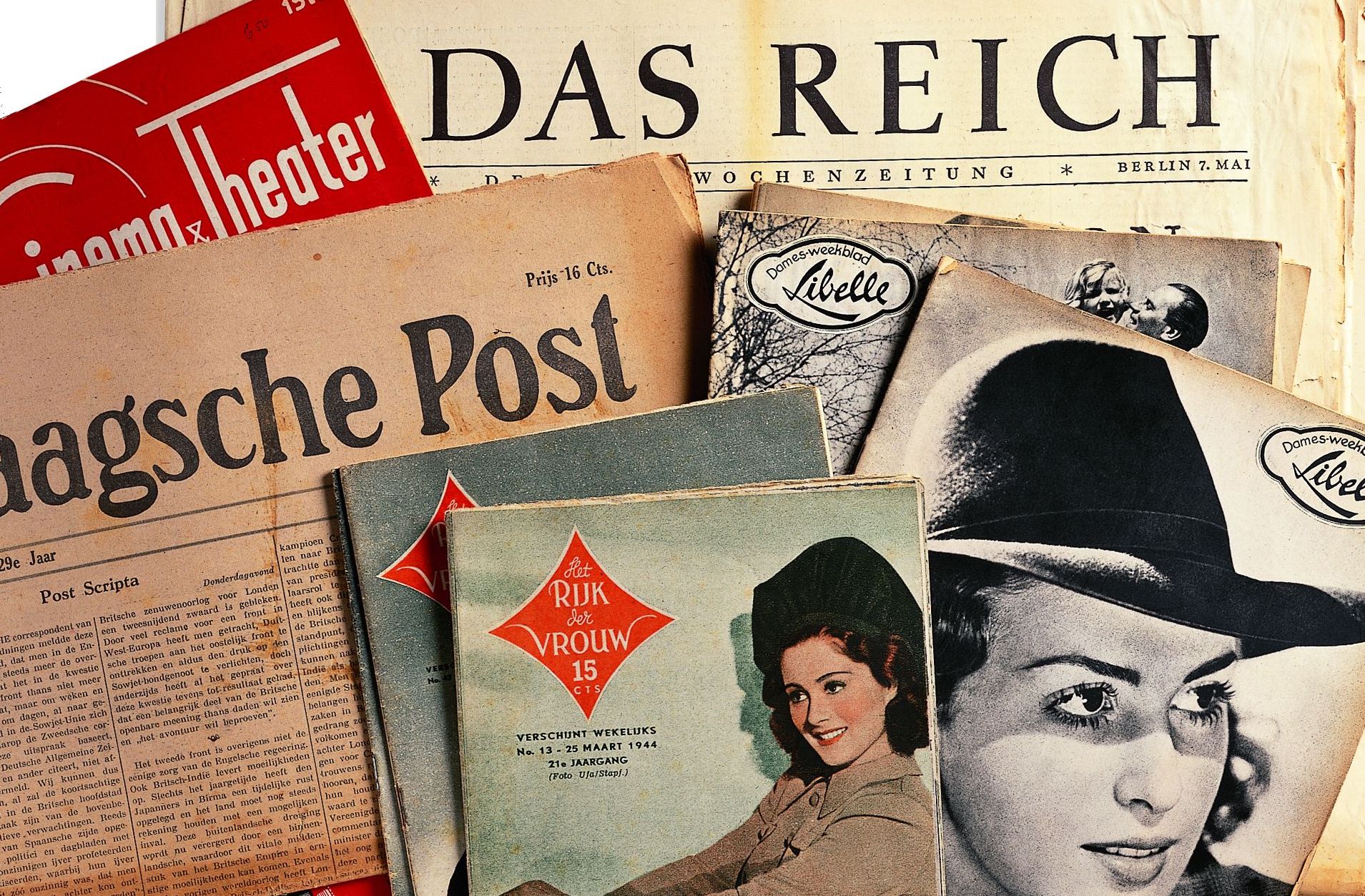Libelle
Libelle was and is a weekly women's magazine. Anne read Libelle and cut pictures from it.

Diverse tijdschriften
Fotograaf: Allard Bovenberg. Collectie: Anne Frankl Stichting Copyright: AFS rechthebbende
Libelle was, and still is, a Dutch magazine for women.[1] The first issue appeared 13 April 1934, published by Uitgeverij en Drukkerij De Spaarnestad.[2] The name comes from 'libellus', Latin for "little book" or "writing".[3] De Spaarnestad was a printer and publisher in the center of Haarlem, located on the Spaarne River, west of Amsterdam. The company was founded in 1906 and grew to become one of the largest publishers of illustrated magazines in the Netherlands. De Spaarnestad was of Roman Catholic origin, a relevant fact given the highly compartmentalized society that characterized the Netherlands in the first half of the twentieth century and which was strongly reflected in the media. In 1910, De Spaarnestad took over publication of the illustrated Katholieke Illustratie (Catholic Illustration) and that magazine, thanks to the purchase of the gravure press in 1915, became the pinnacle of print quality in the Dutch graphic industry. To make the expensive press profitable and stay ahead of the competition, De Spaarnestad began publishing other illustrated weeklies, also aimed at a non-Catholic audience. In the 1920s, the company served virtually the entire Dutch market with magazines such as De Sport. Illustratie, De Stad Amsterdam, Groot-Rotterdam, 's-Gravenhage in Beeld, Brabant in Woord en Beeld, Limburg in Woord en Beeld, and, starting in 1929, Panorama.[4]
Katholieke Illustratie and Panorama became the showpieces of De Spaarnestad, as did the women's magazine Libelle, but soon Libelle had to compete with Margriet, the successful women's magazine of De Geïllustreerde Pers (whose first issue appeared on 30 September 1938), the Catholic competitor from Amsterdam.
During the war, Libelle continued to appear. It contained articles on how to make new clothes from old ones, on the use of surrogates, and the section 'Sumptuous menu' was replaced by 'What's for dinner'. The magazine became thinner and thinner until, due to paper shortages, it was forced to stop by the German occupation forces in September 1944. In March 1946, Libelle appeared again.
Anne wrote in her diary that Bep Voskuijl regularly brought Libelles for her.[5] Anne also wrote that she recognised herself in an article on blushing, written by Sis Heijster[6] and that she would keep it at the back of her diary.[7] Sis Heijster often wrote about adolescence and all that comes with it. Anne cut out the picture that accompanied the article and pasted it on her wall in the Secret Annex.[8] Research has shown that many of the pictures on the wall in Anne's room are from Libelle.[9]
Footnotes
- ^ Zie: Joan Hemels & Renée Vegt, Het geïllustreerde tijdschrift in Nederland: bron van kennis en vermaak, lust voor het oog. Bibliografie. Deel I: 1940-1945, Amsterdam: Otto Cramwinckel, 1993, p. 289-292; Elsbeth Kwant, Marieke van Delft, Reinder Storm (samenst. & red.), Het Tijdschriftenboek, Zwolle: Waanders, 2006, p. 303; Marieke van Delft, Nel van Dijk, Reinder Storm (red.), Magazine! 150 jaar Nederlandse publiekstijdschriften, Zwolle: Waanders, 2006, p. 84-85.
- ^ Diverse jaargangen van Libelle zijn te raadplegen op Delpher, de website van de Koninklijke Bibliotheek, met gedigitaliseerde historische Nederlandse kranten, boeken, tijdschriften en radiobulletins uit bibliotheken, musea en andere erfgoedinstellingen. Vooralsnog ontbreken de oorogsjaren.
- ^ Wikipedia: Libelle (Nederlands weekblad); KB - Topstukken: Tijdschrift Libelle.
- ^ Voor een overzicht van de geschiedenis van het geïllustreerde tijdschrift in Nederland en de rol van uitgeverij De Spaarnestad, zie: Tom van der Linden, Spaarnestad-fotografen: broodfotografen of unieke beeldkunstenaars? Een onderzoek naar de fotografie van uitgeverij De Spaarnestad tussen 1910 en 2000 (Master thesis Media & Journalistiek, Erasmus Universiteit Rotterdam, 2013), p. 23-35; ); Saska Asser, Spaarnestad: Biography of an Analogue Press Photo Archive, TMG: Journal for Media History, 25 (2022) 1, p. 1-30.
- ^ Anne Frank, Diary Version A, 22 December 1943, in: The Collected Works, London [etc.]: Bloomsbury Continuum, 2019.
- ^ Sis Heyster, 'Een lastig verschijnsel', Libelle, nr. 40, 3 oktober 1941, p. 20-22.
- ^ Anne Frank, Diary Version A, 6 January 1944, in: The Collected Works.
- ^ Anne Frank Stichting - Collectie online: Afbeelding van Joyce van der Veen .
- ^ Maartje de Gruyter, De filmsterrenplaatjes van Anne Frank, in: Libelle, (2003) 18 (25 april), p. 64-66